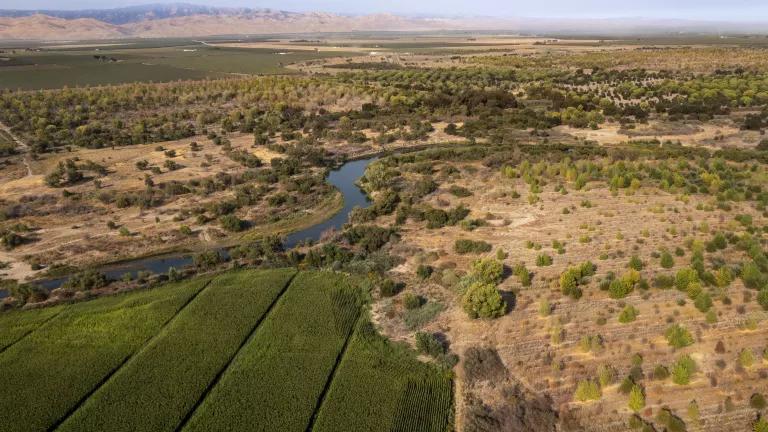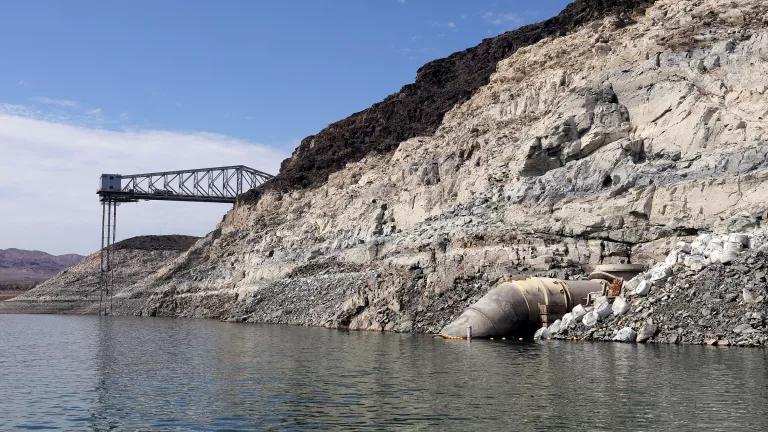Riparian Forests: How California Farmers Can Protect Waterways
California can work with growers to scale up riparian forest buffers along farm and rangelands to help sequester carbon, protect waterways, and improve biodiversity.

A corn field abuts a restored floodplain and riparian habitat along the San Joaquin River in Modesto, California.
Brian van der Brug/Los Angeles Times via Getty Images
Around 200 years ago, California’s Central Valley was covered in a mosaic of wetlands and riparian forest ecosystems. The state’s two major rivers, the Sacramento and San Joaquin, used to flow freely into the Central Valley. The flooding that naturally occurred on these two river ecosystems created ecologically rich riparian zones that buffered the rivers, absorbed excess water during floods, and stabilized nutrients and soil. With their deep root systems and perennial cover, riparian forests built healthy and highly productive soil over millennia. Farmers saw the potential of these soils, and subsequently, the riparian forests were uprooted to support the expansion of agriculture across the Central Valley in the late 1800s and early 1900s.
Now, after decades of extractive agricultural practices, habitat destruction, monocropping, and excessive groundwater pumping, the Central Valley is struggling with critically low groundwater levels, biodiversity losses, and soil health degradation. It’s time to rethink our approach to farming and restore the same ecosystems that once made the Central Valley biologically rich and resilient.
NRDC’s new report “Tapping the Power of Wetlands to Secure a Thriving Planet” builds on research that details the massive co-benefits of riparian restoration and wetland conservation. Riparian forest buffers are an agroforestry practice that involves planting trees, shrubs, or perennial plants between agricultural lands and waterways like rivers and streams. In addition to their carbon sequestration potential, riparian forest buffers offer substantial water quality and conservation benefits. The trees and perennial plants help prevent topsoil and nutrient erosion into waterways by adding taller vegetation that catches nutrients at the edges of a farm; reduce the likelihood of flooding on croplands and increase water storage potential by providing deeper root systems; and provide shade for waterways, which cools water down and prevents harmful algal blooms. Planting riparian forest buffers also adds diversity on farm and rangelands and can provide habitat for wildlife and biodiversity.

Jeremy Swanson for NRDC
Riparian forest buffers, windbreaks, hedgerows, and alley cropping are all considered agroforestry practices. Agroforestry practices can offset up to 33 percent of carbon emissions in the United States, and the most recent IPCC report acknowledges agroforestry’s climate adaptation potential. According to the 2017 Census of Agriculture, 30,853 farm operations across the United States responded that they had used at least one agroforestry practice, representing only 1.5 percent of all farm operations. According to that same census, out of California’s 70,521 farms, only 1,064 used an agroforestry practice. This represents a huge untapped opportunity for California to work with the state’s farmers and ranchers to reintroduce agroforestry practices on farm and rangelands across the state to combat the climate, biodiversity, flood, and drought crises.

2017 Census of Agriculture, USDA
Unfortunately, the two state programs that currently help fund agroforestry and riparian restoration efforts on or near agricultural lands are unable to match the scale and need. The Department of Conservation’s (DOC) Working Lands and Riparian Corridors Program provides grants that restore or enhance riparian areas on farmlands but it has received a paltry $8.4 million over the last three years. The Department of Food and Agriculture’s (CDFA) Healthy Soils Program (HSP) provides grants to farmers to use climate smart agriculture practices. Unfortunately, the HSP is not set up to fund agroforestry projects that take a larger landscape, biodiversity, and watershed view of restoration. The state’s budget deficit and uncertain greenhouse gas reduction fund proceeds mean these two programs are unable to secure the kind of stable, long-term funding needed for restoration. The U.S. Department of Agriculture can support state agroforestry and riparian restoration efforts by centering agroforestry in its Climate-Smart Agriculture and Forestry Strategy. But until that happens, the DOC and CDFA need to collaborate on how to best use limited state funds for projects that maximize water, carbon sequestration, and biodiversity outcomes.
Now’s the time for California to think big, and the state’s historic landscape provides us with a decent road map for the scale of work that we need to accomplish. By prioritizing investments in riparian forest buffers and other agroforestry practices, California can mitigate emissions, adapt to climate change, and support critical biodiversity with the help of our farmers and ranchers.







